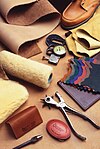Bicast leather
Bicast leather (also spelled as bi-cast leather or bycast leather) is a material made with a split leather backing covered with an embossed layer of polyurethane or vinyl. Bicast leather was originally made for the apparel industry for glossy shoes, and was later adopted by the furniture industry.
Production and features[]
The leather used in the making of bicast is usually a portion of the fibrous, lower grade of leather that remains when the higher-grade grain layer is split off. It is coated with a thin polyurethane or vinyl layer, giving it a uniform shine and a long-lasting "like new" appearance. New bicast leather can have a chemical odor, but this typically dissipates about a week after the piece is exposed to air.[1] Because it is only used for the backing, the leather portion of this material is generally not visible in finished goods.
The use of terms like "genuine leather" or "100% leather" in relation to bicast treatment is considered a misrepresentation and therefore not permitted in some countries, including the UK,[2] Denmark, and New Zealand.[3]
Furniture manufacturers say that the main benefit of bicast leather is its surface appearance at a low price.[1] With constant use, however, the polyurethane layer may crack and split free of its backing, and abrasion may cause large unsightly marks.[2][4]
See also[]
References[]
- ^ a b Gunin, Joan (1 April 2003). "Bycast: Leather's latest price-cutting move". Furniture Today. Furniture Today. Archived from the original on 11 April 2010. Retrieved 24 March 2010.
- ^ a b Gillan, Kevin (17 February 2010). "Bicast leather". Advanced Leather Solutions. Archived from the original on 19 October 2011. Retrieved 24 March 2010.
- ^ "Commission reminds traders: Claims of 100% leave no room for ambiguity". Commerce Commission (New Zealand). 12 August 2004. Retrieved 31 May 2012.
- ^ Stevens, Richard (February 2006). "THE LEATHER CONTROVERSY". Mainly Chairs. Archived from the original on 6 January 2010. Retrieved 24 March 2010.
- Leather
- Leathermaking
